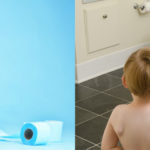Four Basic Guidelines about Toilet Training
- Relax.Toilet training is often the first task that parents take a strong stand on. Sure, it is important to you, but adding tension and pressure to the process will not make it any easier for you or your child, and may make it worse. Remember, unlike eating, sleeping, and playing, there is no natural, immediate payoff for your child when he or she uses the toilet. Your child may not always cooperate with you during toilet training, but your tension will just make things worse. You know your child eventually will learn to use the toilet, so don’t make it a contest of wills. Be calm and patient, and allow your child some time to get the idea.
- Wait.Most children are toilet trained when they are 2, 3, or 4 years old. A few children are ready earlier, but just to be on the safe side, wait until your child is at least 2 years old.
- Make sure you are ready.As a parent you need to make sure you are ready to invest the time and effort in toilet-training your child before you start. The process can be slow and long drawn. Have the grandparents and any other care-giver let up on their pressure about toilet training. Remember, toilet training need not be a community affair. Has the crisis at work passed? Is the household relatively stable now, and will it continue to be so for a few weeks? Having other parts of your life running smoothly will help ease the chore of toilet training.
- Make sure your child is ready.If you are really ready to toilet train, see if your child is ready. Parents and others (grandma, aunt, friends) sometimes push toilet training before there are clear signs that the child is ready. Your child is not ready:
- Just because he’s told you he wants to wear “big boy” pants.
- Just because she wants the Big Wheel you promised as a reward.
- Just because he or she has had some dry days playing on the potty chair. (Many children do this around 18 months of age.)
What Is Readiness?
Age: Your child should be at least 20 months old and preferably 2 years old or older.
Physical readiness: Your child should be able to pick up objects, lower and raise his or her pants, and walk from room to room easily.
Bladder readiness: Your child should already be staying dry for several hours at a time, urinating about four to six times a day, and completely emptying his or her bladder. If your child is still wetting a small amount frequently (7 to 10 times a day), you should wait.
Language readiness: Your child should understand your toileting words, words like “wet,” “dry,” “pants,” and “bathroom.” If your child does not understand what you are talking about, you should wait.
Instructional readiness: Your child should be able to understand simple instructions, such as “Come here, please” and “Sit down.” Just as important, your child should be following the reasonable instructions you give. If your child opposes you much of the time and has frequent temper tantrums, you will probably have problems with toilet training.
Bladder and bowel awareness: Your child may indicate that he or she is aware of the need to void or eliminate. Children usually indicate this awareness not through words but through actions – making a face, assuming a special posture like squatting, or going to a certain location when they feel the urge to urinate or defecate. This may be a positive sign that your child is ready to begin toilet training.
Getting Your Child Ready
You can take some steps now that will help your child when, at some time in the future, you begin toilet training.
Let your child watch you. Your child can learn a lot about how to use the toilet correctly by watching a parent. Frequently let your child come with you when you go to the bathroom. Use simple words to explain what you are doing (for example, “Mommy is going pee-pee in the potty.”).
Teach your child to raise and lower his or her pants. You can do this gradually when you are dressing or undressing your child. With your daughter, for example, you can first pull down her pants with little or no help from her. Then, do less pulling and let her do more. This process may take many weeks, but it is worthwhile. Later, when you begin toilet training, you will be glad that your child already knows how to pull down his or her pants and that you don’t have to tackle that learning task in addition to toilet training.
Help your child learn to follow your instructions. Make sure you have your child’s attention when you give an instruction. Immediately praise your child if he or she does what you ask. If your child does not follow your instruction right away, gently guide him or her through what should be done, and do not give another instruction until the first one has been followed. If your child starts to cry, ignore the crying. When your child has calmed down, repeat your instruction. If you often have trouble getting your child to follow your instructions, ask your health care provider for guidelines on managing your child’s behavior.
Set out a potty chair. A few weeks, or even months, before you think you will start toilet training, make a potty chair available to your child so that he or she can get used to it. Put it in the bathroom or in another room so your child has a chance to investigate it. Let your child get used to sitting on it, with clothes on. Encourage your son to sit on the potty (instead of standing in front of it) so that he will be used to sitting when you start toilet training. (Later on, when he is well past being toilet trained, he can stand.)
Praise your child. Every time your child does something the right way, be sure to let him or her know. Praise your child with words that are brief and to the point, such as “You did a good job pulling down your pants.” Or, give your child a smile, a hug, or a kiss. This attention is how you teach your child what behavior pleases you.
Summary
Just remember the things you can do before beginning to potty train:
- Frequently let your child watch you go to the bathroom.
- Teach your child to raise and lower his or her pants.
- Teach your child to follow your instructions.
- Make sure you are ready before you try to toilet train your child.
- Make sure your child is ready.
- Wait until your child is at least 2 years old.
- Set out a potty chair so your child can get used to it.
- Relax.
- Praise your child every time he or she does any part of toileting behavior correctly.






